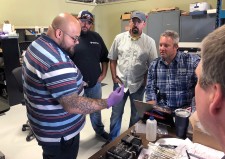Penn College Faculty Prep to Be Pioneers With Electron Beam Welder

WILLIAMSPORT, Pa., June 25, 2019 (Newswire.com) - A week after the spring semester ended, six welding faculty at Pennsylvania College of Technology (https://www.pct.edu/) went back to school – as students. That preparation will equip them to be pioneers this fall when the college becomes the first U.S. educational institution to feature an electron beam welder.
Welding instructors Michael R. Allen, Aaron E. Biddle, Ryan P. Good, Jacob B. Holland, Ty E. Rhinehart and assistant professor James N. Colton II spent three days in Agawam, Massachusetts, training with field engineers from Cambridge Vacuum Engineering (https://www.camvaceng.com/) on an electron beam welder. CVE, an England-based company, is scheduled to deliver a 60kV unit to campus in late October.
“I gave them a day of training yesterday and half a day this morning before I gave them a quiz. They scored higher than I’ve seen anyone do before,” said Tony Slater, technical sales manager for CVE. “I was quite impressed. Teaching to these guys has been a pleasure.”
Penn College faculty initiated the CVE relationship after meeting company representatives a few years ago at FABTECH, North America’s largest metal forming, fabricating, welding and finishing event.
“The faculty had the foresight to think how an electron beam welder could create distinction for our program,” said Loni N. Kline, vice president for institutional advancement. “Tony Slater took the opportunity to advocate within CVE that it made a lot of sense to place this equipment in our facility, so they worked out a deal that made it possible for us to partner.”
Slater’s push for the partnership followed a visit to Penn College and the welding-related instructional space in the Lycoming Engines Metal Trades Center. A 35,000-square-foot expansion of the facility – funded in part by a $2 million grant from the U.S. Department of Commerce’s Economic Development Administration – will be completed by August.
“I realized they are forward thinking, and their attitude toward the students would be a perfect match for us,” Slater said. “What I wanted to do was put an electron beam welder into a learning establishment and have students learn how to EB weld.”
According to Slater, Penn College will be the first learning establishment in the United States and only the second in the world to have an electron beam welder.
“This puts us in exclusive company,” said David R. Cotner, dean of Penn College’s School of Industrial, Computing & Engineering Technologies. “This diversifies our educational portfolio and opportunities for students in what they will get to experience in our two- and four-year degrees. They will have theoretical and practical exposure to electron beam welding.”
That exposure will be facilitated by faculty who successfully completed the training covering machine operations and maintenance for electron beam welding.
“There are different aspects to this that we’re not familiar with at this point in time that we’re trying to get used to,” Allen said. “A lot of it is the measuring of the units.”
“So now we’re dealing with kilovolts and milliamps and things of that nature, when it’s usually just wire-feed speed and the voltage,” Good said. “We got a little more complexity, which I kind of knew about, but the reality didn’t set in until we got here and saw all the different variables that you have under your control.”
Rooted in the aerospace and automotive sectors, electron beam welding is employed to manufacture small components in a variety of industries, such as medical, oil and gas, and semiconductor. It’s a clean process compared to other welding methods because it relies on a narrow beam of electrons for the heat input and doesn’t add filament material or gases. The result is minimal distortion to the welded material.
“You have to take a magnifying glass to see what it (the weld) looks like because it’s such a small bead,” Allen said. “That’s what amazes me the most about the whole thing.”
“Giving them (students) the opportunity to have hands-on exposure to this stuff I think is going to bring them to a whole new level,” Good said.
“In corporate relations, we are hearing from companies that there is an increasing demand for electron beam welding technicians,” Kline said. “It’s great for us to be able to educate students to fill that need.”
Cotner estimates that more than 200 students will experience the electron beam welder during the academic year. The unit is scheduled to be delivered the week of Oct. 21 and be operational before the expanded welding facility is dedicated on Nov. 6.
“Our welding students are always in great demand as they approach graduation,” Cotner said. “Experience on the electron beam welder will give them another tool in their belt. It will also attract new companies to recruit at Penn College, and that will benefit not only welding students but students from other majors.”
Penn College offers a bachelor’s degree in welding and fabrication engineering technology, an associate degree in welding technology, an associate degree in metal fabrication technology and a certificate in welding.
Information about those and other majors offered by Penn College’s School of Industrial, Computing & Engineering Technologies is available by calling 570-327-4520 or visiting www.pct.edu/icet.
For more on Penn College, a national leader in applied technology education, visit www.pct.edu, email admissions@pct.edu or call toll-free 800-367-9222.
Press Contact:
Joe Yoder
Associate President for Public Relations & Marketing at Penn College
570.320.2400 x. 7218
jyoder@pct.edu
Source: Pennsylvania College of Technology